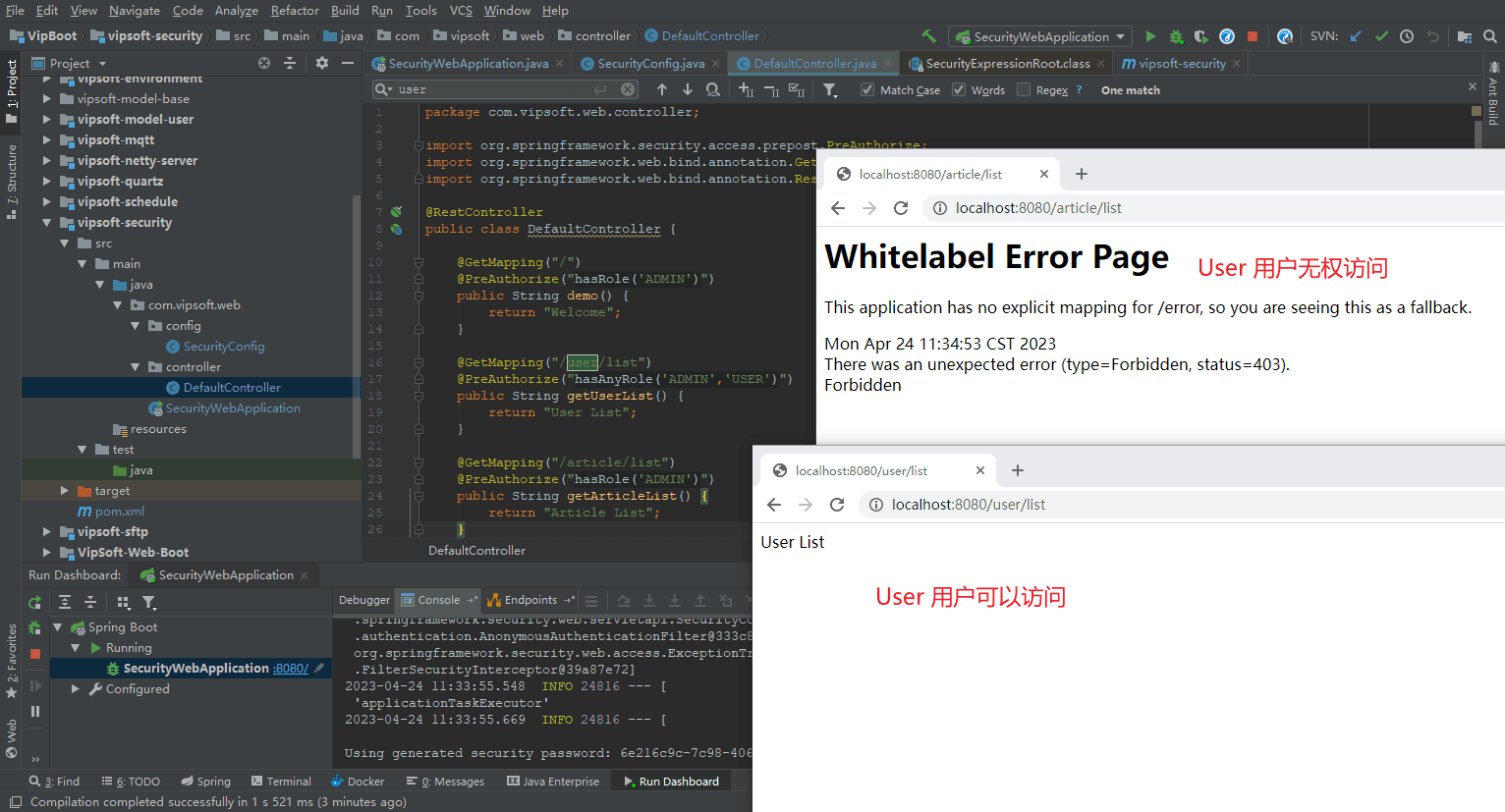
SpringBoot has adopted the default configuration for users, and only needs to introduce pom dependencies to quickly start Spring Security.
Purpose: Verify the identity of the requesting user and provide secure access
Advantages: Based on Spring, easy to configure, reduce a lot of code

Built-in access control method
permitAll() means that anyone is allowed to access the matched URL.
authenticated() means that the matched URLs need to be authenticated before they can be accessed.
anonymous() indicates that the matching URL can be accessed anonymously. The effect is similar to permitAll(), except that the URL set to anonymous() will execute
denyAll() in the filter chain, which means that the matched URLs are not allowed to be access.
rememberMe() Users who are "remember me" are allowed to access this website, which is similar to many websites. There is no need to log in for ten days. You can remember you after logging in once. Then you don’t need to log in for a while.
fullyAuthenticated() Access is only possible if the user is not remembered me. That is to say, you must log in step by step.
Role permissions judgment
hasAuthority(String) Determines whether the user has specific permissions. The user's permissions are Custom login logic
hasAnyAuthority(String ...) If the user has one of the given permissions, access is allowed
hasRole(String) Allow access if the user has the given role. Otherwise, 403
hasAnyRole(String ...) If the user has any one of the given roles, access is allowed
hasIpAddress(String) If the request is for the specified IP, the access will be run. You can get the ip address through request.getRemoteAddr()
Reference Spring Security
Add in the Pom file
<dependency> <groupId>org.springframework.boot</groupId> <artifactId>spring-boot-starter-security</artifactId> </dependency>
<?xml version="1.0" encoding="UTF-8"?>
<project xmlns="http://maven.apache.org/POM/4.0.0"
xmlns:xsi="http://www.w3.org/2001/XMLSchema-instance"
xsi:schemaLocation="http://maven.apache.org/POM/4.0.0 http://maven.apache.org/xsd/maven-4.0.0.xsd">
<parent>
<artifactId>vipsoft-parent</artifactId>
<groupId>com.vipsoft.boot</groupId>
<version>1.0-SNAPSHOT</version>
</parent>
<modelVersion>4.0.0</modelVersion>
<artifactId>vipsoft-security</artifactId>
<version>1.0-SNAPSHOT</version>
<dependencies>
<dependency>
<groupId>cn.hutool</groupId>
<artifactId>hutool-all</artifactId>
<version>5.3.7</version>
</dependency>
<dependency>
<groupId>org.springframework.boot</groupId>
<artifactId>spring-boot-starter-security</artifactId>
</dependency>
<dependency>
<groupId>org.springframework.boot</groupId>
<artifactId>spring-boot-starter-web</artifactId>
</dependency>
<dependency>
<groupId>org.springframework.boot</groupId>
<artifactId>spring-boot-starter-test</artifactId>
<scope>test</scope>
<exclusions>
<exclusion>
<groupId>org.junit.vintage</groupId>
<artifactId>junit-vintage-engine</artifactId>
</exclusion>
</exclusions>
</dependency>
</dependencies>
<build>
<plugins>
<plugin>
<groupId>org.springframework.boot</groupId>
<artifactId>spring-boot-maven-plugin</artifactId>
</plugin>
</plugins>
</build>
</project>The password default user will be automatically generated after running Named: user

#The default configuration will regenerate the password every time the project is started. At the same time, the user name and interception requests cannot be customized. In actual applications, customized configuration is often required. , so next perform custom configuration of Spring Security.
Configure two user roles (admin and user) in memory (to simplify the process and understand the logic), and set different passwords;
Set role access at the same time Permissions, where admin can access all paths (i.e. /*), and user can only access all paths under /user.
Custom configuration class, implements the WebSecurityConfigurerAdapter interface, WebSecurityConfigurerAdapter There are two configure() methods used in the interface, one of which configures the user identity and the other configures User permissions:
configure() method to configure user identity:
SecurityConfig
package com.vipsoft.web.config;
import org.springframework.context.annotation.Configuration;
import org.springframework.security.config.annotation.authentication.builders.AuthenticationManagerBuilder;
import org.springframework.security.config.annotation.method.configuration.EnableGlobalMethodSecurity;
import org.springframework.security.config.annotation.web.builders.HttpSecurity;
import org.springframework.security.config.annotation.web.configuration.EnableWebSecurity;
import org.springframework.security.config.annotation.web.configuration.WebSecurityConfigurerAdapter;
import org.springframework.security.crypto.bcrypt.BCryptPasswordEncoder;
import org.springframework.security.crypto.password.PasswordEncoder;
@Configuration
@EnableWebSecurity
@EnableGlobalMethodSecurity(prePostEnabled = true)
public class SecurityConfig extends WebSecurityConfigurerAdapter {
/**
* 配置用户身份的configure()方法
*
* @param auth
* @throws Exception
*/
@Override
protected void configure(AuthenticationManagerBuilder auth) throws Exception {
PasswordEncoder passwordEncoder = new BCryptPasswordEncoder();
//简化操作,将用户名和密码存在内存中,后期会存放在数据库、Redis中
auth.inMemoryAuthentication()
.passwordEncoder(passwordEncoder)
.withUser("admin")
.password(passwordEncoder.encode("888"))
.roles("ADMIN")
.and()
.withUser("user")
.password(passwordEncoder.encode("666"))
.roles("USER");
}
/**
* 配置用户权限的configure()方法
* @param http
* @throws Exception
*/
@Override
protected void configure(HttpSecurity http) throws Exception {
http.authorizeRequests()
//配置拦截的路径、配置哪类角色可以访问该路径
.antMatchers("/user").hasAnyRole("USER")
.antMatchers("/*").hasAnyRole("ADMIN")
//配置登录界面,可以添加自定义界面, 没添加则用系统默认的界面
.and().formLogin();
}
}Add interface testing
package com.vipsoft.web.controller;
import org.springframework.security.access.prepost.PreAuthorize;
import org.springframework.web.bind.annotation.GetMapping;
import org.springframework.web.bind.annotation.RestController;
@RestController
public class DefaultController {
@GetMapping("/")
@PreAuthorize("hasRole('ADMIN')")
public String demo() {
return "Welcome";
}
@GetMapping("/user/list")
@PreAuthorize("hasAnyRole('ADMIN','USER')")
public String getUserList() {
return "User List";
}
@GetMapping("/article/list")
@PreAuthorize("hasRole('ADMIN')")
public String getArticleList() {
return "Article List";
}
}
The above is the detailed content of How to use SpringBoot SpringSecurity. For more information, please follow other related articles on the PHP Chinese website!




